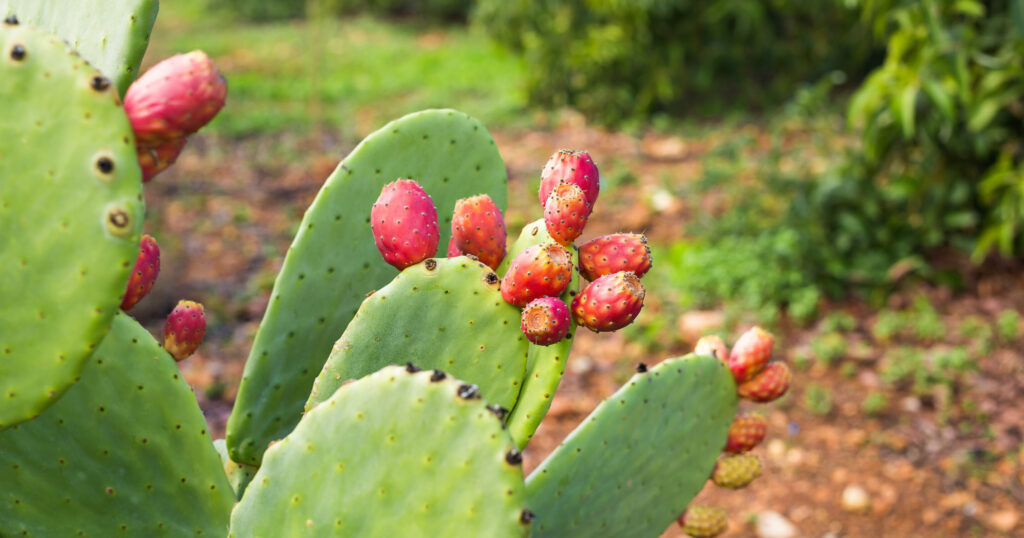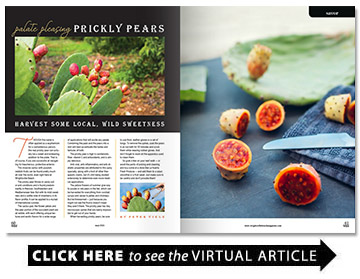Palate Pleasing Prickly Pears
Harvest some local, wild sweetness
BY Peter Viele

Though the name is often applied as a euphemism for a cantankerous person, the real prickly pear can actually be a sweet and endearing addition to the plate. That is, of course, if you are successful at navigating its treacherous, protective exterior.
This invasive cactus with purplish, reddish fruits can be found pretty much all over the world, even right here at Wrightsville Beach.
The prickly pear thrives in sandy soil or arid conditions and is found predominantly in Mexican, Southwestern and Mediterranean fare. But with its mild sweetness and a subtle note of strawberry in its flavor profile, it can be applied to a myriad of international cuisines.
The cactus pad, the flower petals and the pear portion of the succulent plant are all edible, with each offering unique textures and exotic flavors for a wide range of applications that will excite any palate. Combining the pads and the pears into a dish will best accentuate the tastes and textures of both.
The prickly pear is high in carotenoids, fiber, vitamin C and antioxidants, and is simply delicious.
Anti-viral, anti-inflammatory and anti-diabetic properties are attributed to this spiny specialty, along with a host of other therapeutic claims, but it’s still being studied extensively to determine even more medical applications.
The yellow flowers of summer give way to purple or red pears in the fall, which can be harvested for everything from cocktail syrups and salsas to jellies and chutneys. But be forewarned — just because you might not see the thorns doesn’t mean they aren’t there. The prickly pear has tiny, microscopic spines that are nearly impossible to get out of your hands.
When harvesting prickly pears, be sure to use thick, leather gloves or a set of tongs. To remove the spines, soak the pears in an ice bath for 30 minutes and scrub them while wearing rubber gloves. And don’t forget to wash all the apparatus used to clean them.
So grab a few on your next walk — or avoid the perils of picking and cleaning and buy some at a store like La Huerta Fresh Produce — and add them to a salad, smoothie or a fruit salad. Just make sure to be careful and don’t provoke them!
Slow-Cooked Chicken with Prickly Pear and Romanesco
Serves 6
Ingredients
- 6 bone-in chicken legs or leg quarters
- 8 prickly pears (tunas), peeled and quartered
- ¼ cup chicken stock
- 1 head Romanesco, chopped into bite-sized quarters
- 1 orange, juiced
- 1 lime, zested and juiced
- 1 lemon, zested and juiced
- 2 Tbsp apple cider vinegar
- 4 Tbsp brown sugar
- 4 cloves garlic (minced)
- 2 Tbsp dried oregano
- 1 Tbsp chili powder
- 2 Tbsp kosher salt
- 1 tsp black pepper
- 1 bunch green onions, sliced
Preparation
Pat dry chicken and season with salt, pepper, chili powder and oregano. Add to a large slow-cooker and add stock, brown sugar and garlic and cook on medium for 3 and ½ hours. Add Romanesco, prickly pear quarters, apple cider vinegar, orange, lemon and lime juice and zest, and cook for another 2 hours. Serve immediately, garnished with green onions.
Crispy Cactus Fries with Prickly Pear Salsa
Serves 4
Ingredients
Fries
- 2 cactus pads (nopales), spines removed
- 1 cup AP flour
- ¼ cup corn meal
- 1 tsp baking soda
- 1 tsp baking powder
- 1 egg
- 1 ½ cups cold water
- 1 tsp kosher salt
- 2 cups peanut oil
Salsa
- 4 prickly pears (tunas), peeled and diced
- 2 Roma tomatoes, diced
- 1 can fire roasted corn kernels
- ½ lime, juiced
- ½ jalapeño, seeds removed and minced
- ½ bunch cilantro, diced
- 1 Tbsp red wine vinegar
- 1 tsp kosher salt
- ½ tsp sugar
- ¼ tsp cumin
Preparation
If picked fresh, carefully remove spines from the cactus pads with a scrub brush under running water, then use a vegetable peeler to remove bumps. Slice into ¼-inch wide strips. For pear salsa, follow same scrubbing method as cactus pads, then trim the top and bottom off each pear. Use a paring knife to peel off the skin to reveal the fruit. Dice pear, then toss all remaining ingredients for salsa into bowl and set aside at room temperature. Add oil to a large pot and heat to 325 degrees. In a large bowl, whisk together the flour, corn meal, baking soda, baking powder, and a teaspoon of salt. Whisk the egg in a smaller bowl then stir it into the flour mix. Slowly stir in the cold water. Dip the cactus pad strips into the batter then quickly transfer to the hot oil. Cook in batches to allow room, frying for 3 to 6 minutes, until golden brown and crispy. Transfer cooked fries to a plate lined with a paper towel. Season immediately with salt and serve with salsa.
Tacos Nopales
Serves 4
Ingredients
- 1 package of small tortillas
Filling
- 1 tsp vegetable oil
- 2 cactus pads (nopales), spines removed, sliced into strips
- ½ yellow onion, minced
- ½ tsp garlic, minced
- ½ tsp cumin
- ½ tsp sea salt
- ¼ tsp paprika
- ¼ tsp dried ancho or chipotle pepper
- ¼ tsp dried mesquite or applewood seasoning
- ¼ tsp black pepper
- 1/8 cup water
Toppings
- 1 avocado, diced
- ¼ cup red cabbage, minced
- ½ bunch cilantro, diced
- ¼ cup cotija cheese crumbles
- 1 lime, cut into small wedges
- Prickly pear salsa, see salsa recipe on opposite page.
Preparation
If picked fresh, carefully remove spines from the cactus pads with a scrub brush under running water, then use a vegetable peeler to remove bumps. Start a large pot with water and 1/8 cup of salt and bring to a boil. Slice pads into 2-inch strips and gently boil in salt water for 2 minutes. Allow to cool and pat dry with paper towels. Heat cast-iron pan over high heat on stove or grill and add oil. Sear nopales until a light char appears, then reduce heat to medium, add onions and garlic and quickly sear until translucent. Add remaining dry ingredients and water. Lightly toss and remove from heat. Serve immediately with warm tortillas and toppings.
